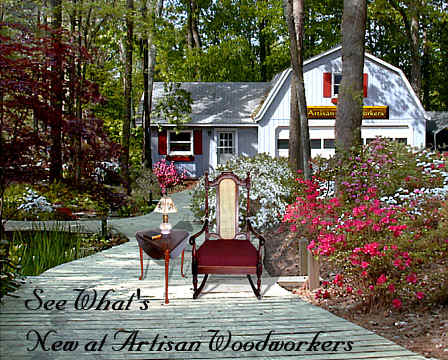

Glossary of Terms,
Antique Furniture
W
Wagon Seat: A crude Early American two-seated settee with a wood frame; rush; splint or wood seat. Originally used atop wagons or a piece of furniture; now mainly as cocktail table top in Colonial reproductions.
Wainscot: Panelwork not covering the wall all the way to the ceiling.
Wainscot Chair: Chair with a heavy, solid paneled back. They were probably developed from the detachment of a piece of wall paneling with a seat-board attachment.
Wall System: A series or combination of wall-hung or free-standing cabinets, shelves, drawers, desks, bar units, etc.
Wardrobe: A large utilitarian cabinet in which to hang clothes.
Warp: A bulging of wood boards due to changes in moisture content. Also in fabric, threads which run lengthwise.
Washstand: Small table or cabinet holding a basin and the accessories for washing, developed during the 18th century.
Water Bench: American, 19th century rustic, usually found on the back porch for the farmhands; usually homemade of available materials, sometimes with a zinc basin, a lower cupboard for pitchers, and an upper shelf.
Waterfall: Term applied to sloping panels of head and/or footboard of modern metal bed. Formally applied to bedroom cases of the 1920's and 1930's with cascading front design.
Water Gilding: Thin deposits of gold and mercury on ormolu mounts.
Webbing: Linen or jute bands woven to form support for spring and filler in upholstered furniture. In Scandinavian-type modern furniture with loose cushioning, webbing is often rubber; in aluminum outdoor furniture, plastic webbing is often used alone as support without cushions.
Webfoot: Grooved or carved foot of a cabriole leg suggesting the webbed feet of animals.
Welsh Cupboard, Welsh Dresser: Cabinet with drawers and door compartments below, the receding upper part having open shelves for the display of china.
Welt: Narrow fabric edging or border of round section sewed into the seams of upholstery for accent and finish.
Whatnot: A piece of occasional furniture made up of a tier of open shelves used to display curios.
Wheat-Ear: Carved ornament representing three or more ears of wheat; a Hepplewhite signature in chairbacks, etc.
Wheel-Back: A chair with round or oval back having radiating design suggesting the spokes of a wheel.
Wicker: General term for furniture woven of various natural or synthetic materials, such as willow, reed, rattan, or spiral twisted paper. Particularly used in summer and outdoor furniture.
William And Mary: Period(1689-1702) in which the baroque influence was brought to England from Holland. Period also marked by introduction of such new pieces as the multi-legged highboy. Salient characteristics; straight trumpet leg braced by curved, flat x-shaped stretcher, often having a center finial.
Window Seat: An upholstered two-seater with arms but no back, originally used in the nook of a window; sometimes built into bay windows.
Windsor: Style of chair using bent wood back frame and wood seat with the legs pegged directly into the seat instead of being framed with aprons. The type seems to have originated around Windsor castle in England between 1700 and 1725, and appears to have been made by wheelwrights or turners rather than by cabinets makers; the English Windsor usually has a pierced slat flanked by turned spindles suggesting wheel spokes. The American colonists carried the Windsor to its ultimate development , producing a chair of the utmost strength, comfort, lightness, and ease of manufacture. They appeared in infinite variations of comb back, fan, hoop, and bow backs, made in a combination of woods. They were often painted of left in the raw wood, and the notion was carried to settees, beds, tables, etc.
Wine table: Horseshoe-shaped table for the serving of wine. English after 1750.
Wing Chair: Comfortable large chair with side pieces, usually overstuffed. The general type existed in France as the "confessional" but the usual implication is the type evolved in England and America.
Winged Claw: Heavy couch foot used in Empire sofas and other heavy pieces.
Writing Arm: Tablet arm; wide board suited for a writing tablet, as in Windsor chairs.
Writing Desk: Flattop desk or any table type of proper size for writing, usually fitted with drawers or desk compartments. Original desk or "bureau" was merely a table with cloth called bure.
